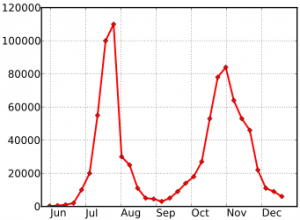I’m not really sure what you mean. There is enough data to make a good estimate of the level of danger – frankly the approach to outbreak control isn’t to simply wait till the number of infected reaches flu levels so that you can make a nice direct comparison between the basic statistics to see how serious it is, but to make considered estimates of the danger based on the data available, the mechanisms of the virus, the means it’s spread, the likelihood of it being spread widely, the infrastructure for national response etc. The mortality rates are based on the data that we have. There had been an assumption from some that this would go down as more data (eg. those infected but with less serious symptoms) was confirmed – it might, but if anything the extra data that’s come in over the last month or so has reinforced that rate estimate.
What I mean is, you are taking a pandemic, let's use the swine flu of 2009 in the chart I posted, which had an incidence of less than 1% (I recall it was 0.026%) and saying that because the incidence rate of covid -19 is currently 1%, it is more dangerous. I disagree with this, because that incidence rate can change (up or down) depending on the size of the sample.
We have had just over 100 cases of covid - 19 to date - take a look at the chart below...

This chart shows the number of swine flu cases per week, in the UK in 2009. Not 100, but almost 120,000 at its peak. You cannot make comparisons between the two at this stage, given the vast difference in numbers. Remember, my position is this: I'm not saying covid-19 is less dangerous, or more dangerous, I'm just saying we don't know yet. I think that's a sensible approach, because what we don't need any more of, are alarmist statements coming from wherever.
I do understand about Outbreak Control btw. I've worked in this field for about 30 years now. If you go back to the other "coronavirus" thread, in the General Chat section, you'll see what was probably the first response I made on this topic, and all the things you mention above about rate of transmission, the national response, etc., are covered. I totally agree with that part of your argument. But we have to strike a balance here between making the general public aware and responsible, and scaring the life out of them for no good reason. There are massive consequences to how we communicate about this responsibly.
The most concerning thing for me about this covid-19 is that we don't understand how it is being transmitted currently. Now that IS different to the flu pandemic I refer to. If we don't know how it is being spread then we can't really do much to stop it. That's the main issue for me, not comparing relative incident rates of death from two totally different things.

